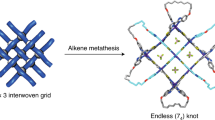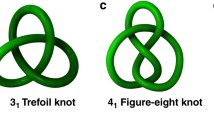Abstract
The properties of knots are exploited in a range of applications, from shoelaces to the knots used for climbing, fishing and sailing1. Although knots are found in DNA and proteins2, and form randomly in other long polymer chains3,4, methods for tying5 different sorts of knots in a synthetic nanoscale strand are lacking. Molecular knots of high symmetry have previously been synthesized by using non-covalent interactions to assemble and entangle molecular chains6,7,8,9,10,11,12,13,14,15, but in such instances the template and/or strand structure intrinsically determines topology, which means that only one type of knot is usually possible. Here we show that interspersing coordination sites for different metal ions within an artificial molecular strand enables it to be tied into multiple knots. Three topoisomers—an unknot (01) macrocycle, a trefoil (31) knot6,7,8,9,10,11,12,13,14,15, and a three-twist (52) knot—were each selectively prepared from the same molecular strand by using transition-metal and lanthanide ions to guide chain folding in a manner reminiscent of the action of protein chaperones16. We find that the metal-ion-induced folding can proceed with stereoinduction: in the case of one knot, a lanthanide(iii)-coordinated crossing pattern formed only with a copper(i)-coordinated crossing of particular handedness. In an unanticipated finding, metal-ion coordination was also found to translocate an entanglement from one region of a knotted molecular structure to another, resulting in an increase in writhe (topological strain) in the new knotted conformation. The knot topology affects the chemical properties of the strand: whereas the tighter 52 knot can bind two different metal ions simultaneously, the looser 31 isomer can bind only either one copper(i) ion or one lutetium(iii) ion. The ability to tie nanoscale chains into different knots offers opportunities to explore the modification of the structure and properties of synthetic oligomers, polymers and supramolecules.
This is a preview of subscription content, access via your institution
Access options
Access Nature and 54 other Nature Portfolio journals
Get Nature+, our best-value online-access subscription
$29.99 / 30 days
cancel any time
Subscribe to this journal
Receive 51 print issues and online access
$199.00 per year
only $3.90 per issue
Buy this article
- Purchase on Springer Link
- Instant access to full article PDF
Prices may be subject to local taxes which are calculated during checkout




Similar content being viewed by others
Data availability
The data that support the findings of this study are available within the paper and its Supplementary Information, or are available from the Mendeley data repository (https://data.mendeley.com/) at https://doi.org/10.17632/zwxxnsjw4p.1.
References
Ashley, C. The Ashley Book of Knots (Doubleday, 1994).
Lim, N. C. H. & Jackson, S. E. Molecular knots in biology and chemistry. J. Phys. Condens. Matter 27, 354101 (2015).
Tubiana, L., Rosa, A., Fragiacomo, F. & Micheletti, C. Spontaneous knotting and unknotting of flexible linear polymers: equilibrium and kinetic aspects. Macromolecules 46, 3669–3678 (2013).
Amin, S., Khorshid, A., Zeng, L., Zimny, P. & Reisner, W. A nanofluidic knot factory based on compression of single DNA in nanochannels. Nat. Commun. 9, 1506 (2018).
Arai, Y. et al. Tying a molecular knot with optical tweezers. Nature 399, 446–448 (1999).
Dietrich-Buchecker, C. O. & Sauvage, J.-P. A synthetic molecular trefoil knot. Angew. Chem. Int. Edn Engl. 28, 189–192 (1989).
Safarowsky, O., Nieger, M., Fröhlich, R. & Vögtle, F. A molecular knot with twelve amide groups—one-step synthesis, crystal structure, chirality. Angew. Chem. Int. Ed. 39, 1616–1618 (2000).
Feigel, M., Ladberg, R., Engels, S., Herbst-Irmer, R. & Fröhlich, R. A trefoil knot made of amino acids and steroids. Angew. Chem. Int. Ed. 45, 5698–5702 (2006).
Adams, H. et al. Knot tied around an octahedral metal centre. Nature 411, 763 (2001).
Barran, P. E. et al. Active metal template synthesis of a molecular trefoil knot. Angew. Chem. Int. Ed. 50, 12280–12284 (2011).
Ponnuswamy, N., Cougnon, F. B. L., Clough, J. M., Pantos, G. D. & Sanders, J. K. M. Discovery of an organic trefoil knot. Science 338, 783–785 (2012).
Prakasam, T. et al. Simultaneous self-assembly of a [2]catenane, a trefoil knot, and a Solomon link from a simple pair of ligands. Angew. Chem. Int. Ed. 52, 9956–9960 (2013).
Ayme, J.-F. et al. Lanthanide template synthesis of a molecular trefoil knot. J. Am. Chem. Soc. 136, 13142–13145 (2014).
Cougnon, F. B. L., Caprice, K., Pupier, M., Bauza, A. & Frontera, A. A strategy to synthesize molecular knots and links using the hydrophobic effect. J. Am. Chem. Soc. 140, 12442–12450 (2018).
Segawa, Y. et al. Topological molecular nanocarbons: all-benzene catenane and trefoil knot. Science 365, 272–276 (2019).
Hartl, F. U., Bracher, A. & Hayer-Hartl, M. Molecular chaperones in protein folding and proteostasis. Nature 475, 324–332 (2011).
Adams, C. C. The Knot Book: An Elementary Introduction to the Mathematical Theory of Knots (W. H. Freeman, 1994).
Eliel, E. L. & Wilen, S. H. Stereochemistry of Organic Compounds (Wiley, 1994).
Gawley, R. E. & Aubé, J. Principles of Asymmetric Synthesis 2nd edn (Elsevier, 2012).
Marenda, M., Orlandini, E. & Micheletti, C. Discovering privileged topologies of molecular knots with self-assembling models. Nat. Commun. 9, 3051 (2018).
Ayme, J.-F. et al. A synthetic molecular pentafoil knot. Nat. Chem. 4, 15–20 (2012).
Ponnuswamy, N., Cougnon, F. B. L., Pantos, G. D. & Sanders, J. K. M. Homochiral and meso figure eight knots and a Solomon link. J. Am. Chem. Soc. 136, 8243–8251 (2014).
Danon, J. J. et al. Braiding a molecular knot with eight crossings. Science 355, 159–162 (2017).
Zhang, L. et al. Stereoselective synthesis of a composite knot with nine crossings. Nat. Chem. 10, 1083–1088 (2018).
Jackson, S. E., Suma, A. & Micheletti, C. How to fold intricately: using theory and experiments to unravel the properties of knotted proteins. Curr. Opin. Struct. Biol. 42, 6–14 (2017).
Flapan, E., He, A. & Wong, H. Topological descriptions of protein folding. Proc. Natl Acad. Sci. USA 116, 9360–9369 (2019).
Mallam, A. L. & Jackson, S. E. Knot formation in newly translated proteins is spontaneous and accelerated by chaperonins. Nat. Chem. Biol. 8, 147–153 (2012).
Zhao, Y., Dabrowski-Tumanski, P., Niewieczerzal, S. & Sulkowska, J. I. The exclusive effects of chaperonin on the behavior of proteins with 52 knot. PLoS Comput. Biol. 14, e1005970 (2018).
Virnau, P., Mirny, L. A. & Kardar, M. Intricate knots in proteins: function and evolution. PLoS Comput. Biol. 2, e122 (2006).
Hill, D. J., Mio, M. J., Prince, R. B., Hughes, T. S. & Moore, J. S. A field guide to foldamers. Chem. Rev. 101, 3893–4012 (2001).
Hecht, S. & Huc, I. (eds) Foldamers: Structure, Properties, And Applications (Wiley-VCH, 2007).
Maayan, G. & Albrecht, M. (eds) Metallofoldamers: Supramolecular Architectures From Helicates To Biomimetics (Wiley-VCH, 2013).
Girvin, Z. C., Andrews, M. K., Liu, X. & Gellman, S. H. Foldamer-templated catalysis of macrocycle formation. Science 366, 1528–1531 (2019).
Garber, S. B., Kingsbury, J. S., Gray, B. L. & Hoveyda, A. H. Efficient and recyclable monomeric and dendritic Ru-based metathesis catalysts. J. Am. Chem. Soc. 122, 8168–8179 (2000).
Forgan, R. S., Sauvage, J.-P. & Stoddart, J. F. Chemical topology: complex molecular knots, links, and entanglements. Chem. Rev. 111, 5434–5464 (2011).
Fielden, S. D. P., Leigh, D. A. & Woltering, S. L. Molecular knots. Angew. Chem. Int. Ed. 56, 11166–11194 (2017).
Conway, J. H. An enumeration of knots and links, and some of their algebraic properties. In Computational Problems in Abstract Algebra (ed. Leech, J.) 329–358 (Pergamon Press, 1970).
Leigh, D. A., Pirvu, L. & Schaufelberger, F. Stereoselective synthesis of molecular square and granny knots. J. Am. Chem. Soc. 141, 6054–6059 (2019).
Sauvage, J.-P. From chemical topology to molecular machines (Nobel lecture). Angew. Chem. Int. Ed. 56, 11080–11093 (2017).
Barry, D. E., Caffrey, D. F. & Gunnlaugsson, T. Lanthanide-directed synthesis of luminescent self-assembly supramolecular structures and mechanically bonded systems from acyclic coordinating organic ligands. Chem. Soc. Rev. 45, 3244–3274 (2016).
Kotova, O., Kitchen, J. A., Lincheneau, C., Peacock, R. D. & Gunnlaugsson, T. Probing the effects of ligand isomerism in chiral luminescent lanthanide supramolecular self-assemblies: a europium “Trinity Sliotar” study. Chem. Eur. J. 19, 16181–16186 (2013).
Gil-Ramírez, G. et al. Tying a molecular overhand knot of single handedness and asymmetric catalysis with the corresponding pseudo-D3-symmetric trefoil knot. J. Am. Chem. Soc. 138, 13159–13162 (2016).
Rapenne, G., Dietrich-Buchecker, C. & Sauvage, J.-P. Resolution of a molecular trefoil knot. J. Am. Chem. Soc. 118, 10932–10933 (1996).
Shen, T. & Wolynes, P. G. Statistical mechanics of a cat’s cradle. New J. Phys. 8, 273 (2006).
de Gennes, P. G. Reptation of a polymer chain in the presence of fixed obstacles. J. Chem. Phys. 55, 572–579 (1971).
Acknowledgements
We thank the Engineering and Physical Sciences Research Council (EP/P027067/1), the European Research Council (Advanced Grant number 786630), the Marie Skłodowska-Curie Actions of the European Union (Individual Postdoctoral Fellowship to F.S., number EC 746993) and the East China Normal University for funding; the University of Manchester Mass Spectrometry Service Centre for mass spectrometry, the Swedish National Infrastructure for Computing at the National Supercomputer Centre at Linköping University for computational resources, and networking contributions from the COST Action CA17139, EUTOPIA (European Topology Interdisciplinary Action). We thank J.-F. Lemonnier and S. Fielden for discussions. D.A.L. is a Royal Society Research Professor.
Author information
Authors and Affiliations
Contributions
F.S. and L.P. devised the original concept. D.P.A., L.P., F.S. and J.S. planned and carried out the synthetic work. J.H.S. performed the computational investigations. D.A.L. directed the research. All authors contributed to the analysis of the results and the writing of the manuscript.
Corresponding author
Ethics declarations
Competing interests
The authors declare no competing interests.
Additional information
Publisher’s note Springer Nature remains neutral with regard to jurisdictional claims in published maps and institutional affiliations.
Supplementary information
Supplementary Information
Experimental procedures and characterisation data.
Rights and permissions
About this article
Cite this article
Leigh, D.A., Schaufelberger, F., Pirvu, L. et al. Tying different knots in a molecular strand. Nature 584, 562–568 (2020). https://doi.org/10.1038/s41586-020-2614-0
Received:
Accepted:
Published:
Issue Date:
DOI: https://doi.org/10.1038/s41586-020-2614-0
This article is cited by
-
Self-assembly of the smallest and tightest molecular trefoil knot
Nature Communications (2024)
-
Mechanical scission of a knotted polymer
Nature Chemistry (2024)
-
Flexibility from fluxionality
Nature Synthesis (2024)
-
What is a mathematician doing…in a chemistry class?
Foundations of Chemistry (2024)
-
A single-domain green fluorescent protein catenane
Nature Communications (2023)
Comments
By submitting a comment you agree to abide by our Terms and Community Guidelines. If you find something abusive or that does not comply with our terms or guidelines please flag it as inappropriate.



